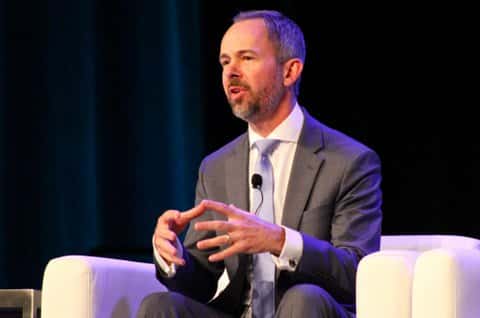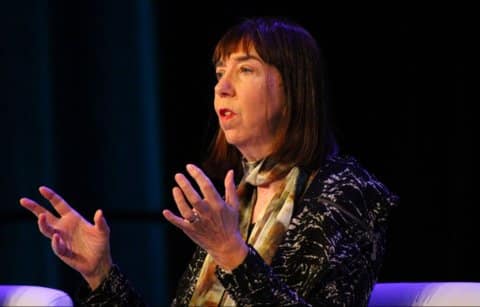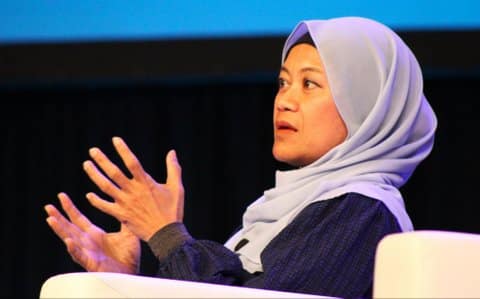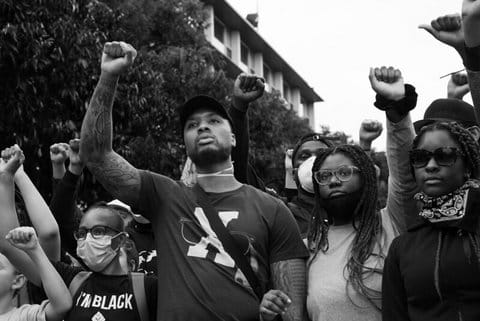
30 Dec ‘Eradicating Hate Begins With Young People’

“I believe very strongly in the power of kids,” said Robert Scherrer at the 2023 Eradicate Hate Global Summit. In a meeting with fellow educators, they “realized that eradicating hate begins with young people.”
Editor’s note: The Eradicate Hate Global Summit began in 2021 in response to the mass shooting at the Tree of Life synagogue in Pittsburgh. This year, The CC Pulse was there for the first time in service of our Stop the Hate coverage. This is one of many stories we will publish that is about or inspired by the summit.
Story and photos by Joe Porrello
PITTSBURGH — Students across the country are joining together to push back against rising hate in schools.
Some of these students and educational working groups that focus on combating hate in academic settings convened at the Eradicate Hate Global Summit in Pittsburgh early this fall to discuss their efforts.
Robert Scherrer, executive director of the Allegheny Intermediate Unit (a Pennsylvania educational body), says children are instrumental in battling bigotry.
“I believe very strongly in the power of kids. They are compassionate. They are kind,” he told The CC Pulse. “If you provide the guardrails for them to do good work, they typically do it.”
This is important because hate in schools has become increasingly widespread in recent years.
According to the Association for Supervision and Curriculum Development, a 2017 national study by UCLA found that after the 2016 election, teachers saw “increased incivility, intolerance, and polarization in classrooms” and “an increase in students making derogatory remarks about other groups during class discussions.” In a March 2019 follow-up study of 505 high school principals, one said students are “more and more willing to say outrageously racist, homophobic, ‘whatever-phobic’ things, believing it is their ‘right’ to do so.”
>>>Read: Online Hate ‘Bleeds Into Real Life,’ Promotes School Bullying
However, some children actively oppose the in-school toxicity and can help promote positivity if given the chance, conference officials said.
During a meeting with local educators, Scherrer said he noticed something was missing: the youth who are subject to the problem at hand.
“We realized that eradicating hate begins with young people,” he said.
Previously employed as a teacher, principal and school superintendent, Scherrer knows the ins and outs of hate in schools.
Eventually, Scherrer helped launch the Eradicate Hate Student Summit, which took place as part of the global summit for the first time this year.
Participating students spoke about current anti-hate campaigns at their schools and came up with new ideas to decrease hate.
They also watched “Repairing the World,” a documentary about the Tree of Life Synagogue massacre and how the Pittsburgh community came together in the aftermath. The global summit itself is an example of this.
“It’s such an impactful film,” said Community Education Through Film Working Group co-chair Debbie Kaplan. “It’s going to serve as the centerpiece for discussion to educate and inform our community about combating and preventing hate.”
Students from the South Allegheny School District who saw the film before the summit were inspired to start their own Eradicate Hate Club.
- Patrice O’Neill, who is based in Oakland, is combating hate via film. Her documentary “Repairing the World” was broadcast nationwide on PBS in October, not long after she spoke at the Eradicate Hate Global Summit.
“Repairing the World” director and producer Patrice O’Neill talked on a panel about how her documentary and her initiative Not In Our Town work to lessen hate. She said that working with others around the country battling bigotry made it evident they were in need of a structure to address the issues.
“We took what we learned from these many communities and what we learned on the ground in Pittsburgh, and we developed a concept paper for hate and bias action teams,” said the Oakland-based O’Neill.
This is meant to help people work at multiple levels to improve hate crime reporting, response and prevention.
Kenneth S. Stern, director of the Bard Center for the Study of Hate, said hate studies are often too siloed as researchers look individually at facets like psychology or culture.
“All of these different aspects of hate actually operate together,” he said. “There’s not a sufficiently robust set of theories from this connection of different fields to provide guidance for what works and what doesn’t work.”
>>>Read: To Stop Hate, Step Out of the Silo
Stern is also co-chair of the summit’s working group on hate studies and higher education. Each group works on their area of focus throughout the year before they all come together to add their findings, ideas and accomplishments to the bigger picture of combating hate.
“The goal of bringing this to the summit is to really put this effort on steroids, to grow the field, and to bring in many new stakeholders,” he said. “What we want to do is collectively help other academic institutions build up hate studies.”
Scherrer hopes that students’ anti-hate work will continue into their adulthood and that the work being done in Pennsylvania schools can be replicated in other locations.
Kaplan said his group wants to hold more community-facilitated discussions, which it thinks could help create a solution to hate.
O’Neill agreed. She said there is a need to build public awareness so that there is an effective response to targets of hate, no matter the victim or scenario.
This resource is supported in whole or in part by funding provided by the State of California, administered by the California State Library in partnership with the California Department of Social Services and the California Commission on Asian and Pacific Islander American Affairs as part of the Stop the Hate program. To report a hate incident or hate crime and get support, go to CA vs Hate.






No Comments